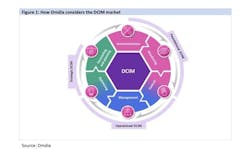Data Center Infrastructure Management (DCIM) market to reach $6.3B by 2030
As data center providers expand their presence into more markets, data center infrastructure management (DCIM) will become a more significant factor in providing monitoring and measuring for remote equipment sites to large hyperscale data center sites.
According to Omdia, DCIM’s market value is expected to reach $6.3 billion by 2030.
While operational teams usually manage power and cooling to maintain the infrastructure's resiliency/availability, Omdia said in its DCIM Market Landscape: The role of DCIM in IT and OT convergence report that a “transformative convergence between IT and OT is taking place across organizations” is taking place.
Further, Omdia's IT Enterprise Insights: IT Spending & Sourcing 2024 survey found that most (65%) of IT budgets will be directed towards maintaining existing systems and services. Meanwhile, 18% will expand current services, and 17% will go towards transformative initiatives in 2024.
Omdia expects organizations to increasingly turn to automation, AI-enabled optimization, and as-a-service models to manage costs and drive more investment towards transformative projects over the next five years.
Rising energy costs
One critical factor affecting DCIM and IT budgets is energy prices, which vary between and within countries.
Although industry watchers expect continued fluctuations driven by market dynamics, fuel types, regulations, weather patterns, and geopolitical uncertainty, Omdia said, there is little indication that energy prices will stabilize soon.
Nevertheless, data centers will require greater amounts of power to support operations. According to a recent International Energy Agency (IEA) report, data centers could double their energy usage by 2026.
IEA forecast that data centers’ total electricity consumption could reach more than 1,000 TWh in 2026.
DCIM rising
In its DCIM model, Omdia considers six key capability areas: instrumentation, monitoring, control, management, optimization, and forecasting.
The research firm groups these capabilities into three distinct categories of DCIM offerings: foundational, operational, and strategic.
Due to the triple effects of the COVID-19 pandemic, supply chain issues and global geopolitical uncertainty, the research firm noted that server output dropped in 2023 following two exceptional years in 2021 and 2022.
Despite the decline in 2023, Omdia sees a growth path for 2024 and the following years.
The research firm expects IT equipment, particularly servers (partially to meet the demands of GenAI) and network equipment (to meet the needs of faster network connectivity), to see year-on-year increases. Also, increased infrastructure necessitates robust monitoring and will drive DCIM revenue.
"DCIM is set to be a $6.3 billion market by 2030, driven by the twin forces of sustainability and the need to optimize efficiency in data centers as the GenAI wave impacts enterprise customers,” said Omdia's Chief Analyst Roy Illsley.
For related articles, visit the Data Center Topic Center.
For more information on high-speed transmission systems and suppliers, visit the Lightwave Buyer’s Guide.
To stay abreast of fiber network deployments, subscribe to Lightwave’s Service Providers and Datacom/Data Center newsletters.
About the Author
Sean Buckley
Sean is responsible for establishing and executing the editorial strategy of Lightwave across its website, email newsletters, events, and other information products.



